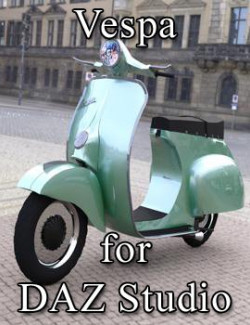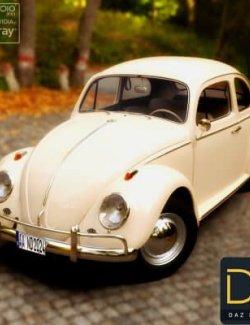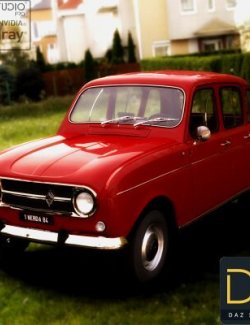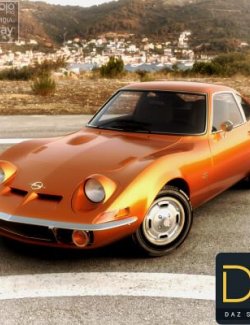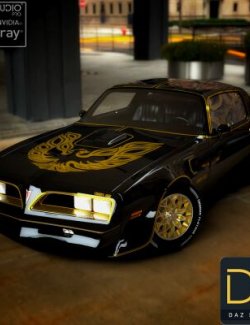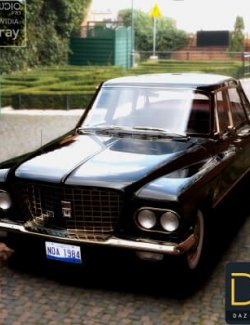Click on image to see gallery.
Warning! Some images may contain nudity and are not suitable for all viewers.
Piaggio Vespa 1961 for DAZ Studio preview image 0Piaggio Vespa 1961 for DAZ Studio preview image 1Piaggio Vespa 1961 for DAZ Studio preview image 2Piaggio Vespa 1961 for DAZ Studio preview image 3Piaggio Vespa 1961 for DAZ Studio preview image 4Vespa (Italian pronunciation: [vspa]) is an Italian brand of scooters and mopeds manufactured by Piaggio. The name means wasp in Italian. The Vespa has evolved from a single model motor scooter manufactured in 1946 by Piaggio & Co. S.p.A. of Pontedera, Italy to a full line of scooters and one of seven companies today owned by Piaggio.
From their inception, Vespa scooters have been known for their painted, pressed steel unibody which combines, in a unified structural unit, a complete cowling for the engine (enclosing the engine mechanism and concealing dirt or grease),a flat floorboard and a prominent front fairing.
After World War II, in light of its agreement to cease war activities with the Allies, Italy had its aircraft industry severely restricted in both capability and capacity.
Piaggio emerged from the conflict with its Pontedera bomber plane plant demolished by bombing. Italy's crippled economy, and the disastrous state of its roads, were not immediately conducive to the redevelopment of the automobile market. Enrico Piaggio, the son of Piaggio's founder Rinaldo Piaggio, decided to leave the aeronautical field in order to address Italy's urgent need for a modern and affordable mode of transportation for the masses.
In 2024, Piaggio celebrated 140 years with limited edition of 'Vespa 140th of Piaggio,' with only 140 units available from April 18th to 21, 2024.
In 1944, Piaggio engineers Renzo Spolti and Vittorio Casini designed a motorcycle with bodywork fully enclosing the drivetrain and forming a tall splash guard at the front. In addition to the bodywork, the design included handlebar-mounted controls, forced air cooling, wheels of small diameter, and a tall central section that had to be straddled. Officially known as the MP5 ("Moto Piaggio no. 5"), the prototype was nicknamed "Paperino" (meaning "Donald Duck" in Italian).Piaggio was displeased with the MP5, especially the tall central section. He contracted aeronautical engineer Corradino D'Ascanio, to redesign the scooter.D'Ascanio, who had earlier been consulted by Ferdinando Innocenti about scooter design and manufacture, made it immediately known that he hated motorcycles, believing them to be bulky, dirty, and unreliable.
D'Ascanio's MP6 prototype had its engine mounted beside the rear wheel. The wheel was driven directly from the transmission, eliminating the drive chain and the oil and dirt associated with it. The prototype had a unit spar frame with stress-bearing steel outer panels.These changes allowed the MP6 to have a step-through design instead of a tall center section like that of the MP5 Paperino. The MP6 design also included a single-sided front suspension, interchangeable front and rear wheels mounted on stub axles, and a spare wheel. Other features of the MP6 were similar to those on the Paperino, including the handlebar-mounted controls and the enclosed bodywork with the tall front splash guard.
Upon seeing the MP6 for the first time, Enrico Piaggio exclaimed: "Sembra una vespa!" ("It looks like a wasp!") Piaggio effectively named his new scooter on the spot.Vespa is both Latin and Italian for wasp—derived from the vehicle's body shape: the thicker rear part connected to the front part by a narrow waist, and the steering rod resembled antennae.
On 23 April 1946, at 12 o'clock in the central office for inventions, models and makes of the Ministry of Industry and Commerce in Florence, Piaggio e C. S.p.A. took out a patent for a "motorcycle of a rational complexity of organs and elements combined with a frame with mudguards and a casing covering the whole mechanical part".
The basic patented design allowed a series of features to be deployed on the spar-frame that would later allow quick development of new models. The original Vespa featured a rear pillion seat for a passenger, or optionally a storage compartment. The original front protection "shield" was a flat piece of aero metal; later, this developed into a twin skin to allow additional storage behind the front shield, similar to the glove compartment in a car. The fuel cap was located underneath the (hinged) seat, which saved the cost of an additional lock on the fuel cap or need for additional metal work on the smooth skin.
The scooter had rigid rear suspension and small 8-inch (200 mm) wheels that allowed a compact design and plenty of room for the rider's legs. The Vespa's enclosed, horizontally mounted 98 cc two-stroke engine acted directly on the rear drive wheel through a three-speed transmission. The twistgrip-controlled gear change involved a system of rods. The early engine had no forced-air cooling, but fan blades were soon attached to the magneto-flywheel (which houses the points and generates electricity for accessories and for the engine's spark) to push air over the cylinder's cooling fins. The modern Vespa engine is still cooled this way.
The MP6 prototype had large grilles on the front and rear of the rear fender covering the engine. This was done to allow air in to cool the engine, as the prototype did not have fan cooling. A cooling fan similar to that used on the MP5 "Paperino" prototype was included in the design of the production Vespa, and the grilles were removed from the fender.
Piaggio filed a patent for the Vespa scooter design in April 1946. The application documents referred to a "model of a practical nature" for a "motorcycle with rationally placed parts and elements with a frame combining with mudguards and engine-cowling covering all working parts", of which "the whole constitutes a rational, comfortable motorcycle offering protection from mud and dust without jeopardizing requirements of appearance and elegance". The patent was approved the following December.
The first 13 examples appeared in spring 1946, and revealed their aeronautical background. In the first examples, one can recognize the typical aircraft technology. Attention to aerodynamics is evident in all the design, in particular on the tail. It was also one of the first vehicles to use monocoque construction (where the body is an integral part of the chassis).
The company was aiming to manufacture the new Vespa in large numbers, and their longstanding industrial experience led to an efficient Ford-style volume production line. The scooter was presented to the press at Rome Golf Club, where journalists were apparently mystified by the strange, pastel colored, toy-like object on display. However, the road tests were encouraging, and even with no rear suspension the machine was more maneuverable and comfortable to ride than a traditional motorcycle.
Following its public debut at the 1946 Milan Fair, the first fifty sold slowly. With the introduction of payment by installments, sales took off.
System Requirements:
PC / MAC 0SX
Product Requirements:
Daz Studio
------------
Ownership Statement:
All of this product's content was created by SamGrey
------------
Installation Instructions:
Open the zip file in WinZip
Click EXTRACT
Verify that ALL FILES is checked
Verify that USE FOLDER NAMES is checked
Extract the folder to C:\Daz 3D\Applications\Data\DAZ 3D\My DAZ 3D Library
==========
DAZ
This pack for Daz Studio contains a Piaggio Vespa 1961 with lights and textures included.
Let your imagination run wild and create wonderful scenarios with this stuff.
Have Fun!!
Mesh data
vertices: 171.178
triángulos: 294.317
Where to buy: RenderHub
Publish date: August 9, 2024

